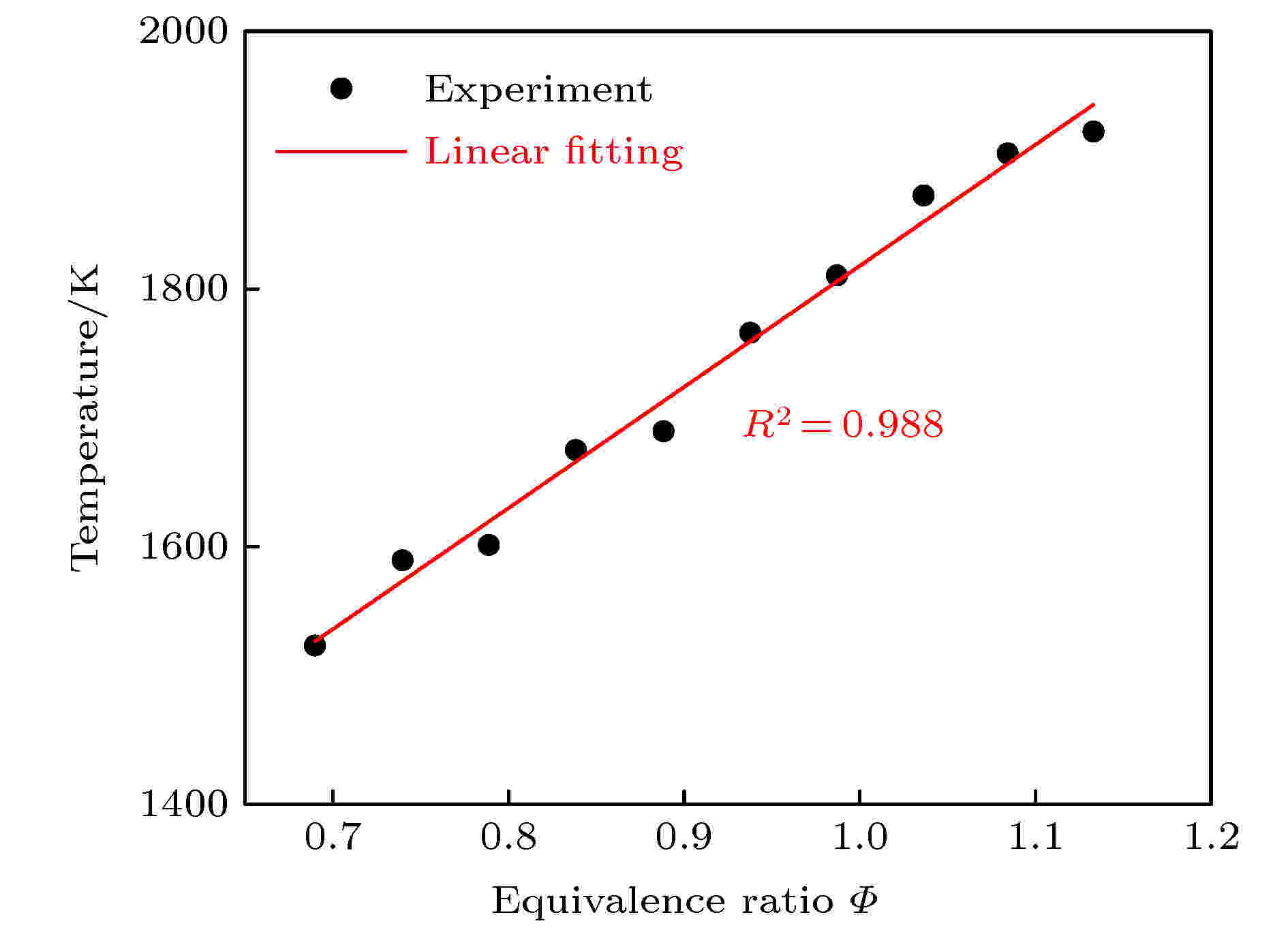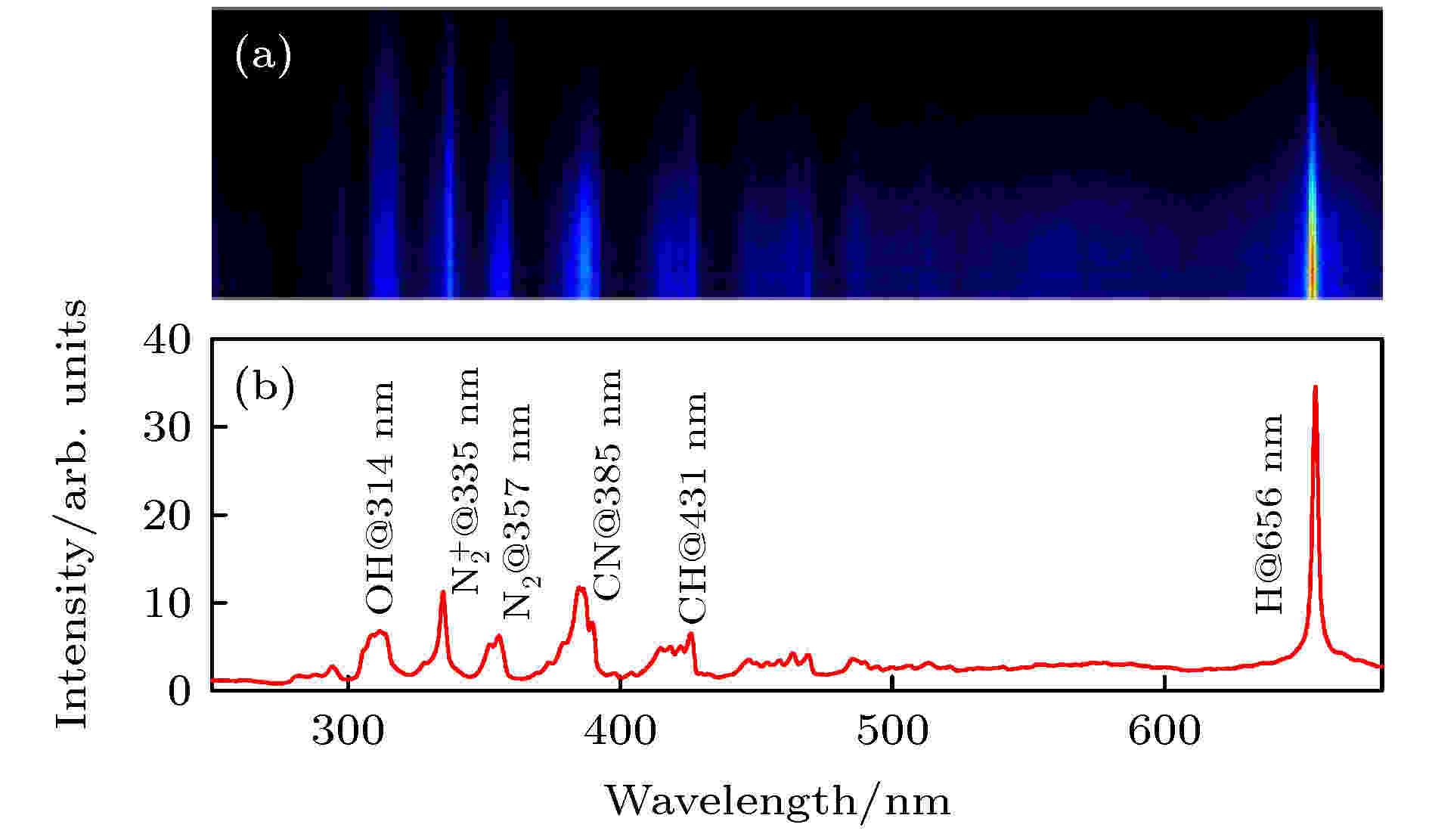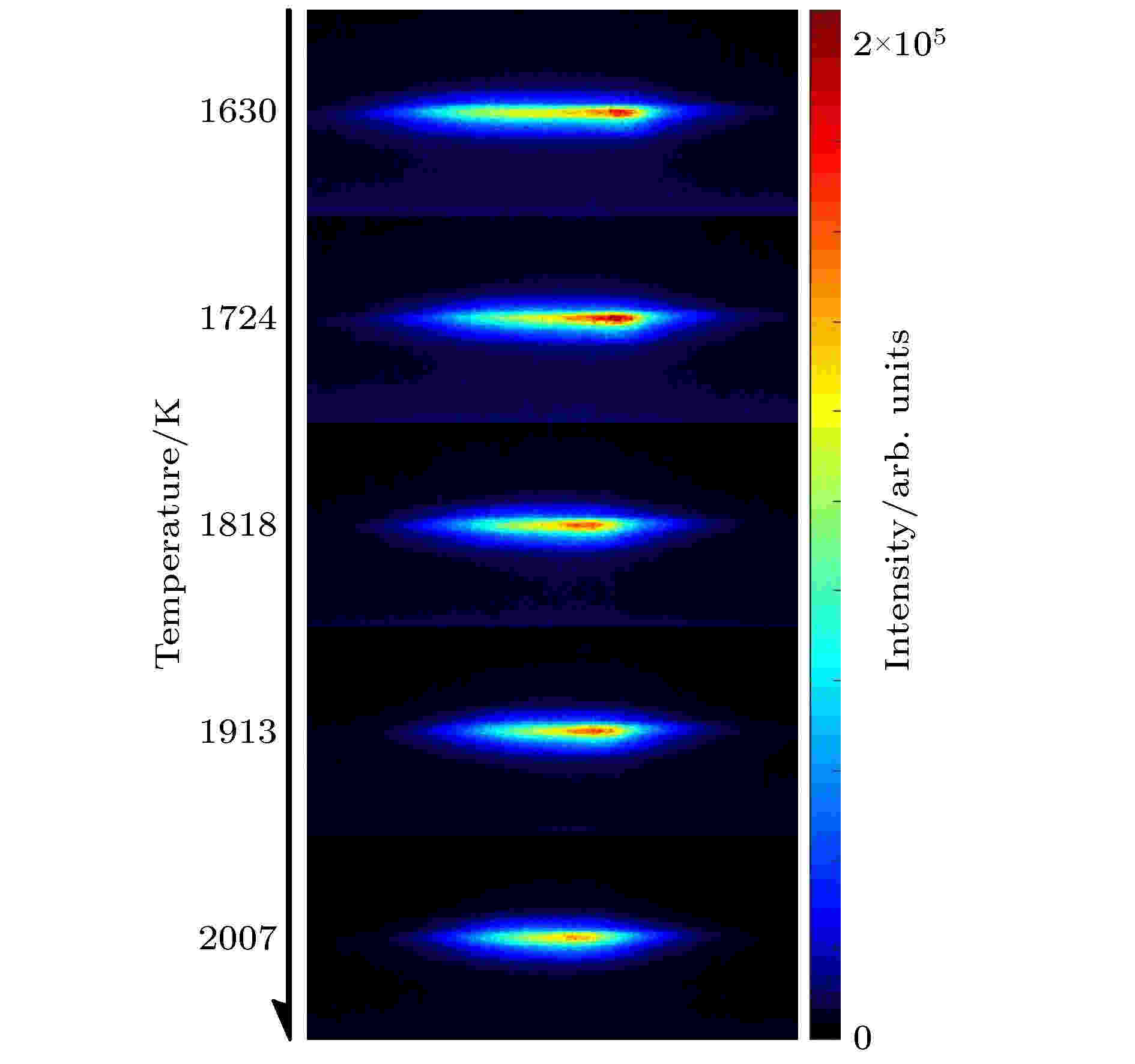全文HTML
--> --> -->目前, 对于温度测量的技术相对较多, 根据其测量方式的不同, 可分为接触式测量和非接触式测量. 接触式测量主要以热电偶[4,5]为代表, 其具有结构简单、操作方便、成本低廉和测温范围广等优点. 但是这种测量方法需在待测燃烧场中侵入探头, 具有干扰性, 并且在实际测量过程中, 会因为侵入热电偶位置的不同而产生不同的热电势. 因此, 热电偶测温方法在燃烧场中具有一定的局限性.
与接触式测量相比, 以可调谐二极管激光吸收光谱技术(tunable diode laser absorption spectroscopy, TDLAS)[6-8]、激光诱导荧光技术(laser-induced fluorescence, LIF)[9,10]、激光诱导热光栅光谱技术(laser-induced thermal gratings spectroscopy, LITGS)[11,12]、瑞利散射技术(Rayleigh scattering, RS)[13]、自发拉曼散射技术(spontaneous Raman scattering, SRS)[14,15]以及相干反斯托克斯拉曼散射技术(coherent anti-Stokes Raman scattering, CARS)[16-18]等为代表的非接触式测量技术具有对待测燃烧场干扰小的优点, 能够实现实时在线温度测量. TDLAS技术具有响应速度快和灵敏度高的优点, 但由于其是视线积分测量, 因此通常情况下TDLAS技术不具备空间分辨能力, 只能反演一维光学路径上的全局温度. 相比于TDLAS技术, 双线LIF测温技术具有空间分辨率高的优点, 其测量通过示踪剂荧光信号强度的比值对于温度的依赖性实现温度的定量测量. LITGS技术无需示踪剂, 通过激光聚焦形成的热光栅周期可以推导出燃烧场的温度信息. 但LITGS信号容易受到气体动力学参数变化的影响, 激发激光的强度或频率的波动也会造成测量误差, 同时该技术对于温度的反演过于复杂. RS技术由于实验系统简单, 信噪比高和时间、空间分辨率好等优点, 被常用于测定湍流火焰温度. 但RS是一种弹性散射, 所采集的信号和入射激光的波长相同, 使得这项技术容易受到背景散射光及各种微粒散射光的干扰; 且RS技术只能应用于主要组分的瑞利散射截面已知的燃烧场, 非常具有局限性. 而SRS技术是一种非弹性散射, 能够对于燃烧场中的温度进行定量测量, 具有较高的空间分辨率. 但是这项技术最主要的缺点是信号很弱, 测量过程中易受干扰. CARS技术由于具有良好的测量精度, 已广泛应用于燃烧场的温度测量, 并且可作为其他光学测温技术开发的标准. 但CARS技术的光路系统复杂, 对于实验条件的要求较为苛刻.
上述介绍的测量方法大多是基于纳秒激光实现的, 随着超快激光技术的发展, 飞秒激光诊断技术逐渐出现, 并为燃烧诊断提供新的工具. 在这方面fs-CARS技术逐渐应用于燃烧场的温度测量[19], 但fs-CARS技术的实验光学系统复杂.
与纳秒激光相比, 飞秒激光具有脉宽极短, 峰值功率极高的特点. 当飞秒激光能量超过临界功率时, 由于光学克尔效应引起的自聚焦和等离子体引起的散焦效应之间达到动态平衡而形成均匀稳定的等离子体通道, 被称为飞秒激光成丝现象[20]. 飞秒激光成丝现象目前已应用到燃烧场的速度和混合分数等方面的测量[21-23], 但在温度测量方面相对较少.
本文从飞秒激光成丝的原理出发, 推导出飞秒激光成丝长度与温度场的函数关系, 通过测量已知不同燃烧场温度下的飞秒光丝长度, 利用幂函数拟合方法, 确定了飞秒光丝长度与温度的关系式, 进而实现燃烧场温度的测量.
飞秒光丝内等离子体的功率密度I可由如下公式表示:

| 气体 | 非线性折射率/10–18 cm2·W–1 |
| 空气 | 1.2 |
| 甲烷 | 1.1 |
表1不同气体非线性折射率n2
Table1.Nonlinear refractive index n2 of different gases.
综上, 我们认为造成飞秒激光成丝长度变化的主要因素来自于燃烧场温度的变化, 而二阶非线性折射率的改变对于飞秒激光成丝的长度影响可以忽略, 即log(Xn2)为常数, 因此飞秒光丝长度与温度的关系可简写成如下形式:
 图 1 实验所用装置及光路图
图 1 实验所用装置及光路图Figure1. Diagram of experimental equipment and light path.
用于采集信号的实验装置包括ICCD(PI MAX3)相机. 其触发信号由飞秒激光器提供. ICCD相机采用的镜头型号为Nikon 50 mm, 实验中采用的光圈为f/1.2. 镜头前加装了滤光片(UG11, 260—380 nm, Andover)用以获取在此波长范围内的N2/

本实验中的燃烧系统采用国内外通用的McKenna燃烧器, 此燃烧器是燃烧领域中的标准燃烧器, 被广泛地应用于燃烧的基础研究和诊断技术的开发, 其主要由供气系统和冷却系统组成. 图2(a)为McKenna燃烧器实物图, 其供气系统由四氟乙烯搭建, 通过热线式质量流量计控制燃空当量比来供给燃料. 其顶部的供气元件主要包括一个位于内圈直径为60 mm的多孔圆形烧结金属板和位于外圈宽为10 mm的环形多孔烧结金属板. 实验中内层通甲烷/空气混合气, 产生稳定的层流预混火焰用于光学诊断, 外层通纯氮气, 用于保护内层的燃烧流场防止周围气体的干扰, 如图2(b)所示, 其供气速度为0.15 m/s.
 图 2 (a) 燃烧器实物图; (b) 甲烷/空气层流预混火焰
图 2 (a) 燃烧器实物图; (b) 甲烷/空气层流预混火焰Figure2. (a) Photo of the McKenna burner; (b) laminar premixed CH4/air flame.
实验分别采用燃空当量比为0.8, 0.9, 1.0, 1.1,1.2, 图3为Rabenstein等[28]应用上述的McKenna燃烧器, 通过拉曼散射技术获得了CH4/air预混火焰燃尽区的温度, 该温度将作为后续实验的参考温度.
 图 3 燃烧场温度随燃空当量比的变化
图 3 燃烧场温度随燃空当量比的变化Figure3. Variation curves of temperature with equivalence ratio in the combustion field.
4.1.飞秒激光成丝
首先在燃烧场中进行了飞秒激光成丝的实验, 观察到了燃烧场中的成丝现象, 如图4(a)所示, 为燃空当量比为0.8的甲烷/空气预混层流火焰中飞秒激光诱导成丝的单反相机拍摄照片, 图4(b)为ICCD成像图. 通过观察图4, 可以发现在一定的空间范围内, 等离子体的强度基本维持不变, 这说明飞秒激光诱导产生的等离子体通道具备一维均匀性. 图 4 (a) 甲烷/空气预混火焰中飞秒激光诱导成丝单反相机拍摄照片; (b) ICCD成像图
图 4 (a) 甲烷/空气预混火焰中飞秒激光诱导成丝单反相机拍摄照片; (b) ICCD成像图Figure4. (a) Digital camera photo and (b) ICCD camera image of femtosecond laser-induced filaments in a premixed CH4/air flame.
其次, 探究了光丝中的信号来源, 测量了飞秒激光成丝的发射光谱, 图5是燃空当量比为0.8的甲烷/空气预混层流火焰燃尽区中飞秒激光成丝的发射光谱. 发射光谱主要来自于OH, N2, CN, CH及H原子等, 其中CH和H原子主要来自于CH4的光解, 而CN是通过复杂的光化学反应生成, 实验主要获取350 nm左右的N2/

 图 5 (a) 甲烷/空气预混火焰中燃尽区飞秒激光成丝的发射光谱成像; (b) 发射光谱
图 5 (a) 甲烷/空气预混火焰中燃尽区飞秒激光成丝的发射光谱成像; (b) 发射光谱Figure5. (a) Emission spectral image and (b) spectral curve of femtosecond laser-induced filament in the burned region of a premixed CH4/air flame.
2
4.2.温度测量
实验在5种不同的已知温度下进行, 根据文献[28]通过控制燃空当量比获得不同的温度, 具体信息如表2所列. 图6为不同温度下, 利用ICCD拍摄的飞秒激光在燃烧场燃尽区不同温度下的光丝长度, 实验中所用激光能量为5 mJ, 传播方向自左向右, 成像信号为100幅图片累加结果, 成像信噪比为337. 从图6中可以看出, 随着温度的降低, 光丝的长度明显变长. 为了便于定量计算光丝长度, 截取成像图的信号区域, 对该部分进行纵向积分处理, 得到沿激光传播方向上的信号空间分布, 如图7所示.| 燃空当量比 | 温度/K |
| 0.8 | 1630 |
| 0.9 | 1724 |
| 1.0 | 1818 |
| 1.1 | 1913 |
| 1.2 | 2007 |
表2不同条件下燃烧场的温度信息
Table2.Flame temperatures with different equivalence ratios.
 图 6 甲烷/空气预混火焰中基于飞秒激光成丝现象测温效果
图 6 甲烷/空气预混火焰中基于飞秒激光成丝现象测温效果Figure6. Temperature measurement based on femtosecond laser-induced filaments in premixed CH4/air flames.
 图 7 不同温度下甲烷/空气预混火焰燃尽区信号空间分布曲线
图 7 不同温度下甲烷/空气预混火焰燃尽区信号空间分布曲线Figure7. Spatial distributions of filament in the burned region of premixed CH4/air flames with different temperatures
图7中不同的颜色代表着不同温度下获得的光丝信号强度的空间分布线型, 从图7可以看出, 不同温度下, 信号峰值的大小基本一致, 但是成丝的空间分布随温度变化. 这是由于温度升高, 粒子数密度降低, 从而导致激光克尔自聚焦效应减弱, 飞秒激光丝长变短. 我们将线型的半高全峰宽定义为光丝的长度, 并建立光丝长度与温度之间的关系曲线.
图8中黑色圆点代表实验测量的数据, 利用(8)式对实验数据点进行幂函数拟合. 红色实线代表幂函数拟合的结果, 其拟合度R2为0.984, 拟合系数A = –4.44 ± 0.38, B = 1.62 ± 0.13. 在温度为2007 K时可算得系统的测量误差为 ± 25 K, 测量精度约为1.2 %. 当温度从1630 K变化到2007 K时, 成丝长度由4.5 mm变化到2.8 mm, 变化了约38 %, 这说明丝长对于温度变化十分敏感. 实验中利用标准板(每个小格1 mm, 每个大格1 cm)对成像图的尺寸进行了标定. 可算得一个像素对应的实际空间尺寸为37 μm. 实际成像系统的空间分辨率是通过空间分辨标靶(USAF 1951)测量. 在本实验条件下, 系统的空间分辨率为50 μm, 对应相机约为1.4个像素. 根据拟合公式(8), 在燃烧场温度为2007 K时光丝长度改变 50 μm, 对应燃烧场温度变化17 K, 即ICCD相机的测温分辨率为17 K. 目前, 我们采用的 ICCD相机的空间分辨力极限可达到10 μm左右, 通过优化, 测温分辨率可进一步提高, 而激光器的能量波动可能会对测量精度造成一定的影响. 目前该技术适用于均匀的燃烧场温度测量, 在常温至高温未燃气体环境下, 该方法仍然具有很好的应用潜力.
 图 8 飞秒激光成丝长度与温度的关系
图 8 飞秒激光成丝长度与温度的关系Figure8. Relation between the length of femtosecond laser fila-ments and temperature.
